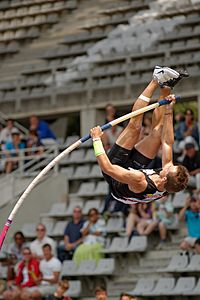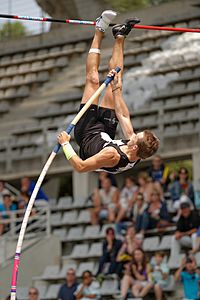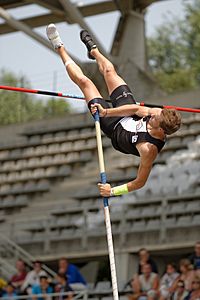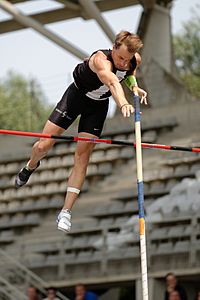Pole vault facts for kids
Quick facts for kids AthleticsPole vault |
|
|---|---|
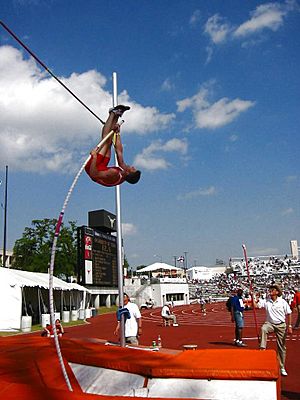
An athlete in the middle of the vaulting phase
|
|
| World records | |
| Men | Renaud Lavillenie 6.16 m (20 ft 2.39468504 in) (2014) |
| Women | Yelena Isinbayeva 5.06 m (16 ft 7.08759843 in) (2009) |
| Olympic records | |
| Men | Thiago Braz da Silva 6.03 m (19 ft 9.27657481 in) (2016) |
| Women | Yelena Isinbayeva 5.05 m (16 ft 6.69389764 in) (2008) |
The pole vault is an exciting track and field event. Athletes use a long, bendy pole to jump over a high bar. Today, these poles are usually made from fiberglass or carbon fiber. People have been pole jumping for a very long time. Ancient Greeks, Cretans, and Celts all knew about it. Pole vaulting has been an official medal event at the Olympics since 1896 for men. Women's pole vault became an Olympic event in 2000.
Contents
How Pole Vault Poles Changed Over Time
At first, pole vaulters used solid poles made from ash wood. As athletes jumped higher, the poles changed. They started using bamboo poles, then hollow aluminum poles. These aluminum poles were thinner at the ends.
Today's poles are much more advanced. They are made by wrapping sheets of fiberglass around a metal shape. This creates a slightly curved pole that bends easily. The way the fiberglass is wrapped makes the pole a certain length and stiffness. Different types of fibers, like carbon fiber, are added. This helps poles have special features for higher jumps. Carbon fiber makes poles lighter.
Landing Safely: The Evolution of Mats
Just like in the high jump, the landing area used to be simple. Athletes would land on a pile of sawdust or sand. But as vaulters jumped higher, better landing areas were needed.
Now, landing mats are made of large foam chunks. Modern mats are usually about 1 to 1.5 meters (3 to 5 feet) thick. These mats are also getting bigger to help prevent injuries. Athletes should land on their back or shoulders. Landing on your feet should be avoided to protect your ankles.
Rules have also changed over the years. This has led to bigger landing areas. All hard surfaces around the pit must now have extra padding.
The Crossbar: What It's Made Of
The crossbar is what athletes try to jump over. It used to be a triangular aluminum bar. Now, it's a round fiberglass bar with rubber ends. This bar rests on stands and can be easily knocked off. Newer rules mean the pegs holding the bar are shorter. The ends of the crossbar are also semi-circular.
Understanding Pole Vault Technique
Pole vaulting looks complicated, but it can be broken down into several steps. Each step helps the vaulter get over the bar.
The Approach: Running Fast
The first step is the approach. The vaulter sprints down the runway. They need to gain maximum speed. They also need to be in the right position to jump. Top vaulters use 18 to 22 strides (steps).
The run starts strong and relaxed. The vaulter runs upright, with knees lifted. Their body leans slightly forward. As they speed up, their body becomes straighter. The pole tip is held high until the last few steps. Then, the vaulter lowers the pole tip. This helps them run faster as they get ready to plant the pole. The faster they run, the more energy they build up for the jump.
Plant and Take-off: Bending the Pole
This phase starts about three steps before the final jump. Vaulters count their steps backward from the box. They usually count steps taken with their left foot. The last three steps are quicker. These are called the "turn-over."
The goal here is to use the running energy to bend the pole. This stores energy in the pole. The vaulter also wants to gain as much height as possible. They raise their arms high above their head. The right arm is straight up, and the left arm is out to the side. At the same time, they drop the pole tip into the vault box. On the last step, the vaulter jumps off their back leg. This leg stays straight. They drive their front knee forward. As the pole slides into the box, it starts to bend. The vaulter continues to move up and forward.
Swing Up: Getting Upside Down
In this step, the vaulter swings their back leg forward. They also pull the pole down with their top arm. This helps keep the pole bent for longer. It also helps the vaulter get into the best position. The goal is to do these movements quickly. It's a race against the pole straightening.
This action creates a double swinging motion. The top of the pole moves forward from the box. The vaulter swings from their right hand. This helps the vaulter get into a good position to be "launched" off the pole. The swing continues until the vaulter's hips are above their head. Their arms pull the pole close to their chest. From there, they push their legs up over the crossbar.
Extension: Pushing Upward
The extension means the vaulter pushes their hips upward. Their legs are straight. Their shoulders drive down. This puts the vaulter upside down. This position is called "inversion."
As this happens, the pole starts to straighten. This pushes the vaulter quickly upward. The vaulter's hands stay close to their body. They move from their shins to their hips and upper body.
The Turn: Spinning Around
The turn happens right after the extension. The vaulter spins 180 degrees toward the pole. They extend their arms down past their head and shoulders. They also start to angle their body toward the bar. This phase is like a spin around an imaginary line from head to toe.
Fly-Away: Clearing the Bar
This is the final and often easiest part of the vault. It happens naturally if the other steps are done correctly. The vaulter pushes off the pole and lets it go. The pole falls away from the bar and the mats.
As the vaulter's body goes over the bar, they face the bar. Their body rotates naturally. The main thing is to make sure their arms or head don't knock the bar off. The vaulter should land safely in the middle of the foam mats. They should land face up.
Related Sports
Images for kids
-
Pole vault in the 1890s at US Naval Academy
-
Pole vaulter Allison Stokke prepares for her jump.
See also
 In Spanish: Salto con pértiga para niños
In Spanish: Salto con pértiga para niños


